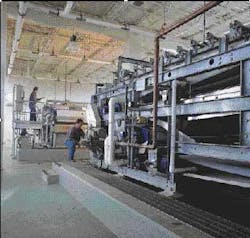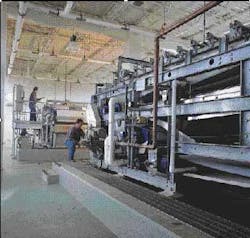By John Civardi
Like factories, drinking water treatment facilities transform a raw material into a usable product. During this transformation, suspended solids, dissolved substances and other residuals are removed from the raw water and require separate treatment for proper disposal. These factories, therefore, produce both drinking water and waste streams that must be processed by the water treatment facility.
Traditionally, drinking water treatment plant residuals have been processed through disposal into large, open lagoons; direct discharge back to the water source; or direct discharge to sewers.
Over the past several decades, changing regulations, shrinking budgets, and various environmental concerns have changed how residuals are disposed. For example, lagoons create soil and groundwater contamination and are increasingly unattractive due to cost and scarcity of land. Discharging chemically treated water back to its source or to sewers threaten waterways and can foul utility infrastructure systems. In addition, as water demand increases, water professionals must limit the amount of water wasted during treatment processes.
In order to address these concerns, while improving the operational effectiveness of treatment processes, water utilities have turned to mechanical dewatering technologies traditionally used to treat wastes from the pulp and paper and mineral refining industries. The pioneers who transformed mechanical dewatering technologies to treat drinking water encountered operational difficulties including high chemical usage, substandard waste production, and poor reliability.
However, mechanical dewatering technologies have come a long way over the past 30 years and continue to evolve. Selecting the proper equipment and installing effective mechanical dewatering systems requires careful planning, especially considering that conditions vary greatly from system to system. Mechanical dewatering systems are successful when:
1. An accurate assessment of the quantity and quality of the residuals is undertaken
2. Bench and pilot tests are conducted to determine the most suitable and cost effective alternative
3. Residuals disposal alternatives are determined early on to clarify dewatering objectives, and
4. The impact of recycle streams on the treatment plant has been assessed in terms of turbidity and filter run length.
Process Overview
Before selecting the optimum mechanical dewatering equipment, utilities must first:
• Characterize the quality of residuals. The quality of the residuals will determine the disposal options. Of particular concern is the concentration of heavy metals, which can be determined through a full metal analysis.
• Estimate the quantity of residuals to be generated. The quantity of wastewater and solids generated will determine the size of the dewatering treatment facilities. Residuals should be characterized for the annual average day production and maximum day, week and month productions. These values influence the size of the treatment systems and the disposal site's ability to handle the waste volumes. Design failures often result from an underestimation of solids generation rates.
• Identify end users. The selection of the treatment technology also depends on the ultimate disposal site for the residuals, such as landfills or sludge processing facilities. Each disposal option has limits concerning the solids concentration and the quality and quantity of residuals.
• Perform a desktop evaluation. The desktop evaluation includes bench testing multiple technologies to evaluate their performance on a conceptual level. During this evaluation period, residuals are tested to estimate solids concentration. Design information (equipment size, capital and operating costs) is also developed during this phase. In addition, a comparison of the technologies is performed so that one or two technologies can be selected for actual pilot testing.
• During this process, water systems can develop a qualitative ranking system based on a broad spectrum of criteria that will likely vary from system to system.
• Visit/inspect similar installations. Utility operators should independently evaluate potential equipment in operation at other facilities. Examining equipment in use and talking with operators can yield valuable, first-hand insights not likely to be otherwise available.
• Pilot test selected treatment technologies. Utilities should perform pilot tests using full-scale unit(s) and equipment to obtain the maximum solids loading on the dewatering device as well as parameters such as belt speed, gravity force, chemical dosages, solids concentration, and filtrate quality. This is a critical step in the process since no two treatment systems are likely to be identical because the quality of raw water and the equipment selected will be unique to each system.
• Unlike drinking water pilot plant testing that use equipment sized for reduced flows (20 gpm or less), mechanical dewatering pilot testing typically involves full-scale units. The use of full-scale equipment for an existing plant provides accurate design and performance data. The pilot testing is then used to obtain the maximum solids loading on the dewatering device as well as parameters such as belt speed, G force, chemical dosages, solids concentration, filtrate quality, among others.
• Implementation. Design and construction of mechanical dewatering facilities can begin once the bench and pilot tests are complete, the quality and quantity of residuals and their end use (e.g., beneficial reuse, land filling, etc.) have been determined, and the proper equipment selections have been made.
Case Study
Trenton Water Works' Water Filtration Plant, Trenton, NJ, is a 50 mgd plant that treats water from the Delaware River using a split alum clarification system consisting of conventional flocculation/ clarification and solids contact clarifiers followed by dual media filtration.
A number of factors drove TWW to consider mechanical dewatering, including:
• changing regulations that prohibited discharge of residuals to the river
• space was not available for non-mechanical dewatering
• limited capacity of the municipal wastewater treatment plant would not allow direct disposal to sewers
• significant fluctuations in turbidity
Hatch Mott MacDonald (formerly Killam Associates) ("HMM") based its design considerations on a careful assessment of physical and natural conditions, end users of the residuals, and economic parameters. HMM characterized the water filtration plant residuals and used TWW's comprehensive database of residuals production to validate the data. HMM also performed a comprehensive survey of water treatment plants throughout the region as potential users of the residuals. The next step required a desktop evaluation of belt filter presses, centrifuges, and pressure filters. Belt filter presses (BFP) offered TWW the best solutions, especially given their ease of maintenance and operational flexibility.
HMM inspected other full scale mechanical dewatering systems and interviewed operating staff to gain first-hand insights about the system. TWW pilot tested two types of belt presses each one meter in width. Through pilot testing, HMM could determine the press throughput (in pounds per day of solids) along with polymer feed rate and pressate volumes and solids concentrations. The pilot testing demonstrated that cake solids of 25% could be achieved while meeting the maximum production capacity of the water filtration plant.
The full-scale plant includes four two-meter presses preceded by gravity thickeners, and spent filter backwash treatment. Thickeners were provided as pretreatment and for sludge equalization and storage. Between the thickeners and presses, mixing equalization basins were installed to uniformly mix the sludge from the thickeners and provide a uniform and consistent feed to the press.
The new mechanical dewatering equipment enables TWW to now recycle all liquid residuals. The new equipment reduces disposal costs, ensures environmental compliance, and provides high quality drinking water to the City of Trenton.
Conclusion
Mechanical dewatering systems enable water utilities to improve efficiency and reduce disposal volumes and water wastage. However, since raw water, site, and other conditions vary from facility to facility, utilities should thoroughly assess their systems, needs, and constraints in order to select the mechanical dewatering equipment that best suits the utility's specific requirements. Selecting the right equipment will ensure optimum performance and maximize return on investment.
About the Author: John Civardi, P.E., is a project manager with Hatch Mott MacDonald and consults clients on the selection, design, and construction of diverse water treatment processes and systems. He can be contacted by email at: [email protected].




